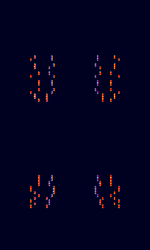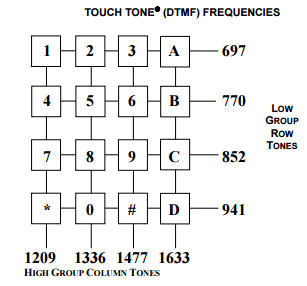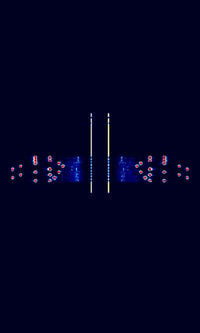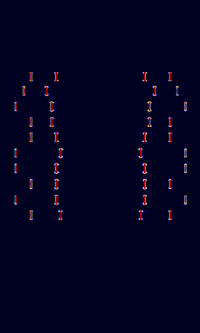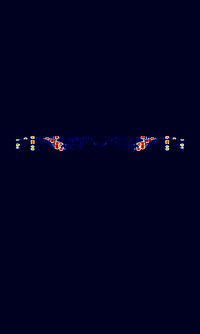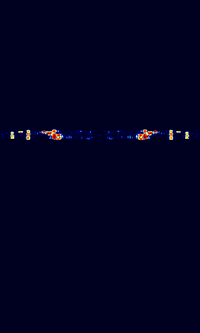Dual Tone Multi Frequency (DTMF)
DTMF is a signaling mode used for a variety of purposes. It's most known for telephony dialing, but is in use for many different applications such as DTMF paging for DTMF-enabled VHFVery High Frequency (30-300 MHz)/UHFUltra High Frequency (300-3000 MHz) radios and as a marker on broadcasting stations for switching between regional and local programming for events like local news broadcasting.
DTMF uses the dual-tone method, where each symbol is represented by a combination of two distinct tones.
The A,B,C, and D tones are actually originally part of an old US Military telephone system called Autovon.
- A (697/1633): Flash Override (FO)
- B (770/1633): Flash (F)
- C (852/1633): Immediate (I)
- D (941/1633): Priority (P)
These keys were for the urgency of the call. The highest, Flash Override, would effectively interrupt all ongoing calls and give the speaker full command. This system began operation in 1966 and ended in the early 1990's when a newer system, the Defense Switched Network, replaced Autovon.
Nowadays, the ABCD keys (as well as * and # ) are used infrequently and are for operations unrelated to their original purpose. On telephone networks, such keys are used for network control, such as cycling through different carriers. For amateur radio and commercial two-way radio systems, the keys are used for equipment control, repeater control, remote base operations, and some telephone communications systems.
The tone duration of DTMF is variable depending on the system used. Standard Whelen timing is 40ms tone, 20ms space, where standard Motorola rate is 250ms tone, 250ms space. Federal Signal ranges from 35ms tone 5ms space to 1000ms tone 1000ms space. Genave Superfast rate is 20ms tone 20ms space. Genave claims their decoders can even respond to 20ms tone 5ms space.
In general, DTMF's speed when being send manually (as people type on a DTMF keypad) will be variable and not rigidly structured, as in tone length and space length will happen loosely as the keys are pressed. Electric systems using DTMF dialing will be rigid and have equal tone and break lengths between tones.
Samples[edit]
x/y, x=tone duration, y=space duration
| Normal 50/50 | Motorola 250/250 | Whelen 40/20 |
|---|---|---|
| Genave 20/20 | Genave 20/5 |
|---|---|
Decoding Software[edit]
- Hobby Level Software
- Professional Software
Video Examples[edit]
- Touch-Tone DTMF
- Amateur Radio: DTMF Use
- DTMF Decoder Demo
- Remote Control, Kenwood TM VT71A using a Handy Talkie. (or other DTMF capable radio)- AF5DN
- DTMF метки русских FM-радиостанции (DTMF on russian FM radio)
- DTMF for Android
Additional Links[edit]
- Genave Electronics DTMF Information
- WAVECOM Database: DTMF
- Connect Systems Incorporated Programming Manual with DTMF
- Tone Signaling Charts
- Federal Signal DTMF Siren Encoder/Decoder Spec sheet
- Wikipedia DTMF
- RiverDevil Info on DTMF on ham repeater systems
- MultiPSK DTMF
